Investigating Risk Factors Associated with Childhood Obesity in the UK
VerifiedAdded on 2024/05/29
|12
|2625
|337
Report
AI Summary
This research proposal investigates the risk factors associated with childhood obesity in the UK, addressing its economic, social, and governmental costs, including depression and bullying. The study highlights the increasing prevalence of childhood obesity in the UK, attributing it to genetic, behavioral, and environmental factors. The research employs both qualitative and quantitative methodologies, incorporating a literature review and graphical representations via a Gantt chart. The aim is to identify these risk factors, assess the current situation, and determine the severity of associated risks. Objectives include developing a framework for guidance, identifying specific risks, and understanding the reasons behind childhood obesity. The literature review emphasizes the importance of parental education, healthy eating habits, and active lifestyles. The methodology involves primary and secondary data collection, including sampling, questionnaires, and analysis of existing data. The research also uses qualitative and quantitative methods to analyze the collected data and provide recommendations for minimizing childhood obesity in the UK.

Research Project
1
1
Paraphrase This Document
Need a fresh take? Get an instant paraphrase of this document with our AI Paraphraser

Contents
Introduction......................................................................................................................................3
Research Topic................................................................................................................................4
Research Aims.................................................................................................................................4
Research Objectives.........................................................................................................................4
Research Questions..........................................................................................................................4
Literature Review............................................................................................................................5
Methodology....................................................................................................................................9
Timescale.......................................................................................................................................10
References......................................................................................................................................12
2
Introduction......................................................................................................................................3
Research Topic................................................................................................................................4
Research Aims.................................................................................................................................4
Research Objectives.........................................................................................................................4
Research Questions..........................................................................................................................4
Literature Review............................................................................................................................5
Methodology....................................................................................................................................9
Timescale.......................................................................................................................................10
References......................................................................................................................................12
2
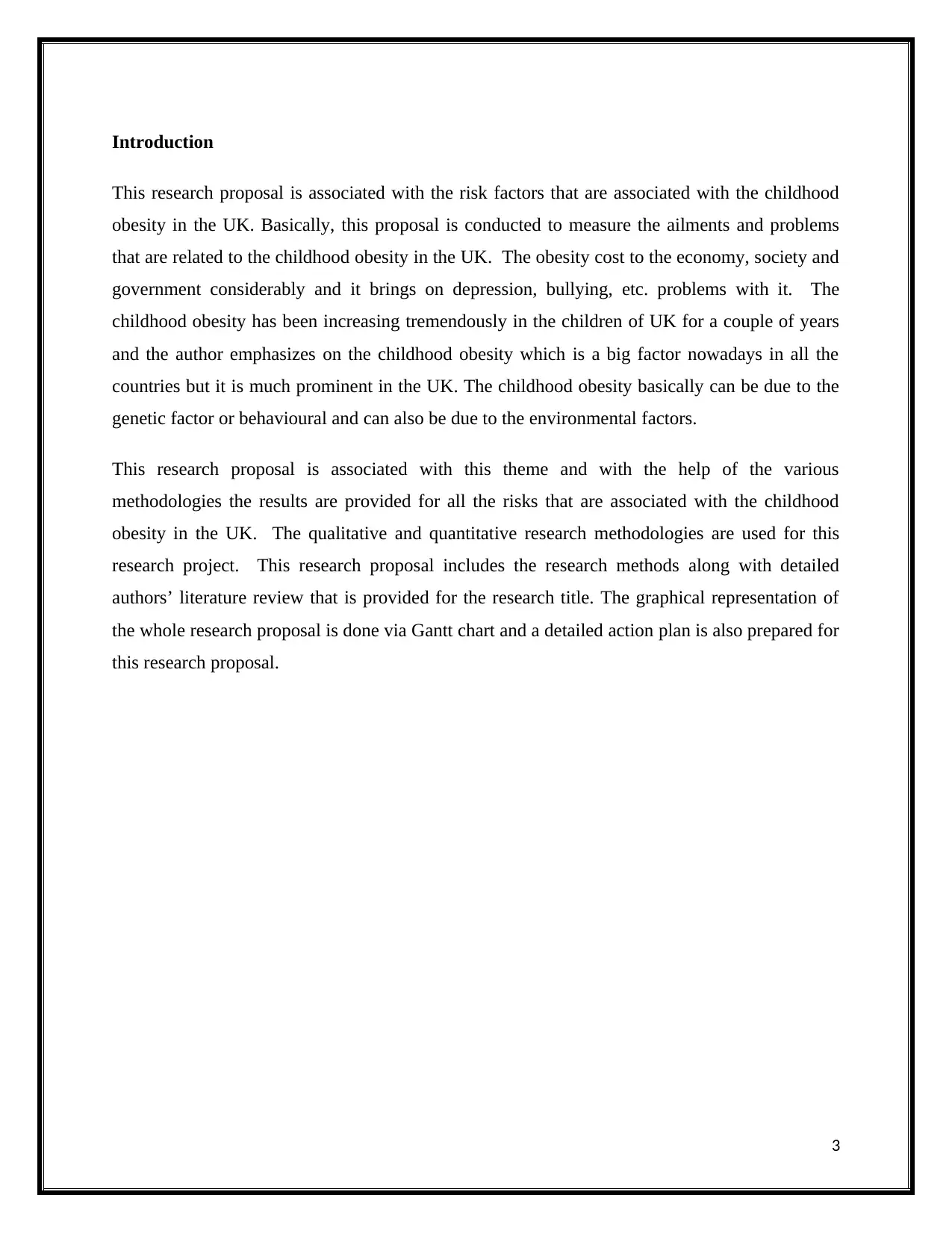
Introduction
This research proposal is associated with the risk factors that are associated with the childhood
obesity in the UK. Basically, this proposal is conducted to measure the ailments and problems
that are related to the childhood obesity in the UK. The obesity cost to the economy, society and
government considerably and it brings on depression, bullying, etc. problems with it. The
childhood obesity has been increasing tremendously in the children of UK for a couple of years
and the author emphasizes on the childhood obesity which is a big factor nowadays in all the
countries but it is much prominent in the UK. The childhood obesity basically can be due to the
genetic factor or behavioural and can also be due to the environmental factors.
This research proposal is associated with this theme and with the help of the various
methodologies the results are provided for all the risks that are associated with the childhood
obesity in the UK. The qualitative and quantitative research methodologies are used for this
research project. This research proposal includes the research methods along with detailed
authors’ literature review that is provided for the research title. The graphical representation of
the whole research proposal is done via Gantt chart and a detailed action plan is also prepared for
this research proposal.
3
This research proposal is associated with the risk factors that are associated with the childhood
obesity in the UK. Basically, this proposal is conducted to measure the ailments and problems
that are related to the childhood obesity in the UK. The obesity cost to the economy, society and
government considerably and it brings on depression, bullying, etc. problems with it. The
childhood obesity has been increasing tremendously in the children of UK for a couple of years
and the author emphasizes on the childhood obesity which is a big factor nowadays in all the
countries but it is much prominent in the UK. The childhood obesity basically can be due to the
genetic factor or behavioural and can also be due to the environmental factors.
This research proposal is associated with this theme and with the help of the various
methodologies the results are provided for all the risks that are associated with the childhood
obesity in the UK. The qualitative and quantitative research methodologies are used for this
research project. This research proposal includes the research methods along with detailed
authors’ literature review that is provided for the research title. The graphical representation of
the whole research proposal is done via Gantt chart and a detailed action plan is also prepared for
this research proposal.
3
⊘ This is a preview!⊘
Do you want full access?
Subscribe today to unlock all pages.

Trusted by 1+ million students worldwide

Research Topic-
“What are the risk factors associated with childhood obesity in the UK"
Research Aims
The research aim is to determine and identify the risk factors that are associated with the obesity
in children and also to find out the current situation regarding obesity in children related to
lifestyle in the UK and determining the severity of the risks associated.
Research Objectives
The objectives of this research are as follows:-
- To develop a framework for the guidance of childhood obesity
- To determine different risks associated with the childhood obesity.
- Identifying the reasons behind childhood obesity.
Research Questions
Q.1- What are the factors which causing Childhood obesity in the UK?
Q.2- How could childhood obesity be minimized in the UK?
Q.3- What are the frameworks and approaches to guide the childhood obesity in the UK?
4
“What are the risk factors associated with childhood obesity in the UK"
Research Aims
The research aim is to determine and identify the risk factors that are associated with the obesity
in children and also to find out the current situation regarding obesity in children related to
lifestyle in the UK and determining the severity of the risks associated.
Research Objectives
The objectives of this research are as follows:-
- To develop a framework for the guidance of childhood obesity
- To determine different risks associated with the childhood obesity.
- Identifying the reasons behind childhood obesity.
Research Questions
Q.1- What are the factors which causing Childhood obesity in the UK?
Q.2- How could childhood obesity be minimized in the UK?
Q.3- What are the frameworks and approaches to guide the childhood obesity in the UK?
4
Paraphrase This Document
Need a fresh take? Get an instant paraphrase of this document with our AI Paraphraser

Literature Review
According to Deneke (2017), the childhood obesity has been increasing tremendously in the
children of UK for a couple of years and the author emphasizes on the childhood obesity which
is a big factor nowadays in all the countries but it is much prominent in the UK. Childhood
obesity is very common in every second child of the UK and worldwide (Deneke, 2017). The
factors that lead to excess weight gain are mostly the psychosocial issues due to which more than
50% of the children are getting obese. Furthermore, the author states that due to the increasing
childhood obesity, many problems are arising from diabetes in children, behavioural problems,
etc. The childhood obesity basically can be due to the genetic factor or behavioural and can also
be due to the environmental factors (Deneke, 2017).
In the words of Skinner et. al. (2015), it is very important to find a solution to childhood obesity
in the UK. Therefore, the various factors that lead to obesity, are studied and the author states
that the obesity is very much preventable as well as the risks associated with it. The risks of non-
communicable disease, depression, etc., are all preventable if the obesity is prevented and taken
care of at the early stage itself in the children. The author emphasizes that the parents need to be
educated first to prevent the obesity in the children (Skinner, et. al., 2015). Further Skinner et.
al. (2015), The main reason behind the health issues should be studied and the parents should be
educated to involve their children more on the physical activities then letting them stay at home
and watch television, also indoor games should be restricted so that the issues related to the
health and obesity are all tackled. The percentages of the children that are aged between 4-5 are
at higher risks of gaining weight through the lifestyle they adopt (Skinner, et. al., 2015). The
childhood obesity in the UK is increasing at a fast rate and can only be decreased by educating
the parents on the importance of healthy eating habits as well as the adoption of a lifestyle that is
healthy. The obesity hampers the overall growth of the children greatly as per the researches did
earlier and therefore the childhood obesity should be treated at an early stage itself.
As per the conversation with Wilkie et. al. (2016), the genetic reason for obesity is the strongest
factor that prevails in the children of UK along with their fast-food eating habits. It last few
years lots of researchers have done to find out the genes that contributed towards this problem,
and they have found success also (Wilkie, et. al., 2016). Interestingly, it is emphasized that the
5
According to Deneke (2017), the childhood obesity has been increasing tremendously in the
children of UK for a couple of years and the author emphasizes on the childhood obesity which
is a big factor nowadays in all the countries but it is much prominent in the UK. Childhood
obesity is very common in every second child of the UK and worldwide (Deneke, 2017). The
factors that lead to excess weight gain are mostly the psychosocial issues due to which more than
50% of the children are getting obese. Furthermore, the author states that due to the increasing
childhood obesity, many problems are arising from diabetes in children, behavioural problems,
etc. The childhood obesity basically can be due to the genetic factor or behavioural and can also
be due to the environmental factors (Deneke, 2017).
In the words of Skinner et. al. (2015), it is very important to find a solution to childhood obesity
in the UK. Therefore, the various factors that lead to obesity, are studied and the author states
that the obesity is very much preventable as well as the risks associated with it. The risks of non-
communicable disease, depression, etc., are all preventable if the obesity is prevented and taken
care of at the early stage itself in the children. The author emphasizes that the parents need to be
educated first to prevent the obesity in the children (Skinner, et. al., 2015). Further Skinner et.
al. (2015), The main reason behind the health issues should be studied and the parents should be
educated to involve their children more on the physical activities then letting them stay at home
and watch television, also indoor games should be restricted so that the issues related to the
health and obesity are all tackled. The percentages of the children that are aged between 4-5 are
at higher risks of gaining weight through the lifestyle they adopt (Skinner, et. al., 2015). The
childhood obesity in the UK is increasing at a fast rate and can only be decreased by educating
the parents on the importance of healthy eating habits as well as the adoption of a lifestyle that is
healthy. The obesity hampers the overall growth of the children greatly as per the researches did
earlier and therefore the childhood obesity should be treated at an early stage itself.
As per the conversation with Wilkie et. al. (2016), the genetic reason for obesity is the strongest
factor that prevails in the children of UK along with their fast-food eating habits. It last few
years lots of researchers have done to find out the genes that contributed towards this problem,
and they have found success also (Wilkie, et. al., 2016). Interestingly, it is emphasized that the
5

healthy eating habits should be followed by the families to overcome the problem of the
childhood obesity.
Wilkie et. al. (2016), also stated that obesity is the extra fat which defects the body in the manner
to stop functioning and create diseases which makes a person unable to work. The obesity is
increasing in children because of unhealthy activities and food. The scenario has been changed
and this is majorly affected the UK. In UK children are mostly unhealthy and overweight
because of the junk food and trend of eating out. This is because the childhood obesity and
various factors of this obesity are in UK (Wilkie, et. al., 2016). Here are the statistics provided
for measuring and predicting the future of childhood and young people in England. The below
provided graphical presentation shows the obesity or overweighed children percentage in the
different age group in UK.
Figure-1
Source- (Schmidt, et. al., 2016)
6
childhood obesity.
Wilkie et. al. (2016), also stated that obesity is the extra fat which defects the body in the manner
to stop functioning and create diseases which makes a person unable to work. The obesity is
increasing in children because of unhealthy activities and food. The scenario has been changed
and this is majorly affected the UK. In UK children are mostly unhealthy and overweight
because of the junk food and trend of eating out. This is because the childhood obesity and
various factors of this obesity are in UK (Wilkie, et. al., 2016). Here are the statistics provided
for measuring and predicting the future of childhood and young people in England. The below
provided graphical presentation shows the obesity or overweighed children percentage in the
different age group in UK.
Figure-1
Source- (Schmidt, et. al., 2016)
6
⊘ This is a preview!⊘
Do you want full access?
Subscribe today to unlock all pages.

Trusted by 1+ million students worldwide
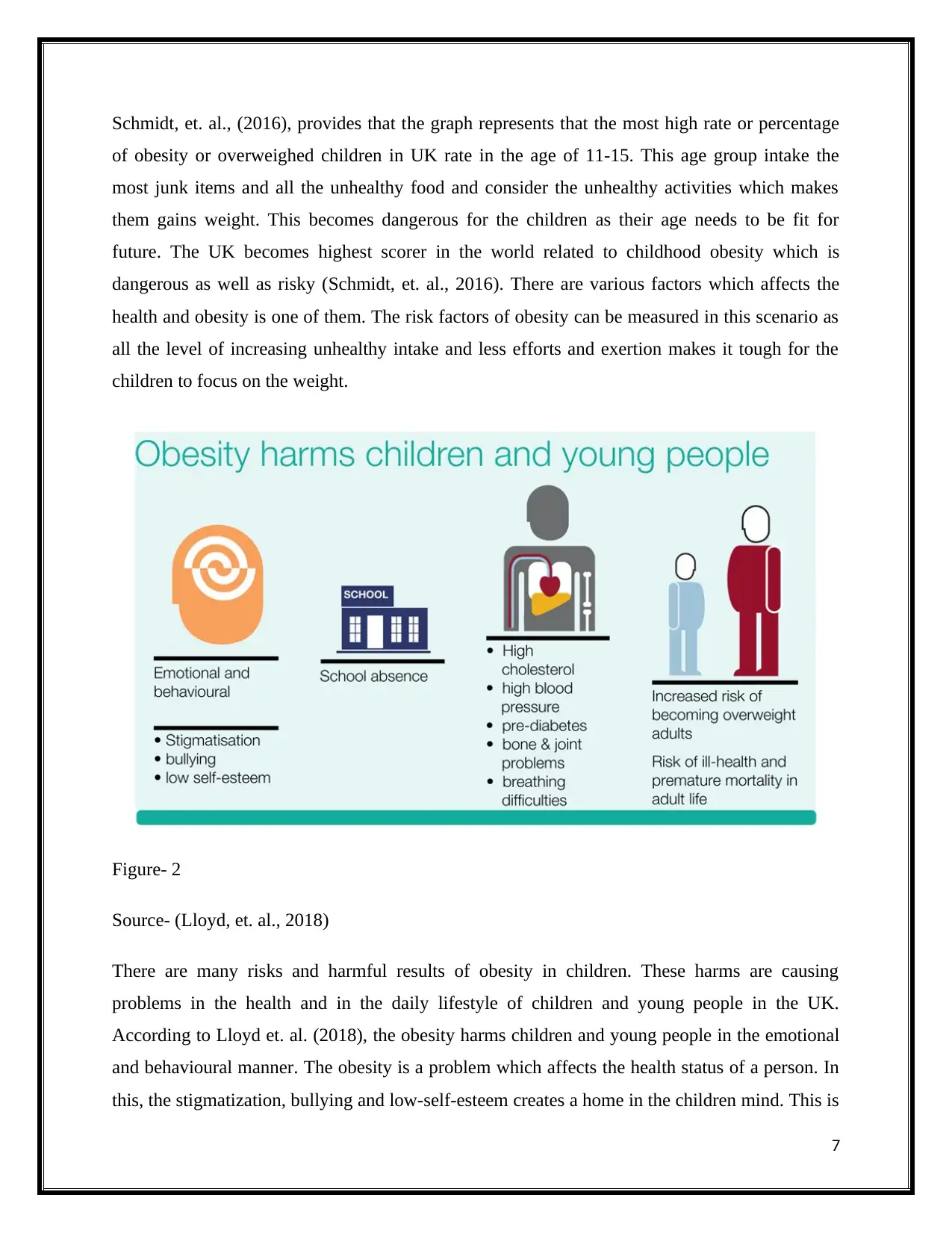
Schmidt, et. al., (2016), provides that the graph represents that the most high rate or percentage
of obesity or overweighed children in UK rate in the age of 11-15. This age group intake the
most junk items and all the unhealthy food and consider the unhealthy activities which makes
them gains weight. This becomes dangerous for the children as their age needs to be fit for
future. The UK becomes highest scorer in the world related to childhood obesity which is
dangerous as well as risky (Schmidt, et. al., 2016). There are various factors which affects the
health and obesity is one of them. The risk factors of obesity can be measured in this scenario as
all the level of increasing unhealthy intake and less efforts and exertion makes it tough for the
children to focus on the weight.
Figure- 2
Source- (Lloyd, et. al., 2018)
There are many risks and harmful results of obesity in children. These harms are causing
problems in the health and in the daily lifestyle of children and young people in the UK.
According to Lloyd et. al. (2018), the obesity harms children and young people in the emotional
and behavioural manner. The obesity is a problem which affects the health status of a person. In
this, the stigmatization, bullying and low-self-esteem creates a home in the children mind. This is
7
of obesity or overweighed children in UK rate in the age of 11-15. This age group intake the
most junk items and all the unhealthy food and consider the unhealthy activities which makes
them gains weight. This becomes dangerous for the children as their age needs to be fit for
future. The UK becomes highest scorer in the world related to childhood obesity which is
dangerous as well as risky (Schmidt, et. al., 2016). There are various factors which affects the
health and obesity is one of them. The risk factors of obesity can be measured in this scenario as
all the level of increasing unhealthy intake and less efforts and exertion makes it tough for the
children to focus on the weight.
Figure- 2
Source- (Lloyd, et. al., 2018)
There are many risks and harmful results of obesity in children. These harms are causing
problems in the health and in the daily lifestyle of children and young people in the UK.
According to Lloyd et. al. (2018), the obesity harms children and young people in the emotional
and behavioural manner. The obesity is a problem which affects the health status of a person. In
this, the stigmatization, bullying and low-self-esteem creates a home in the children mind. This is
7
Paraphrase This Document
Need a fresh take? Get an instant paraphrase of this document with our AI Paraphraser
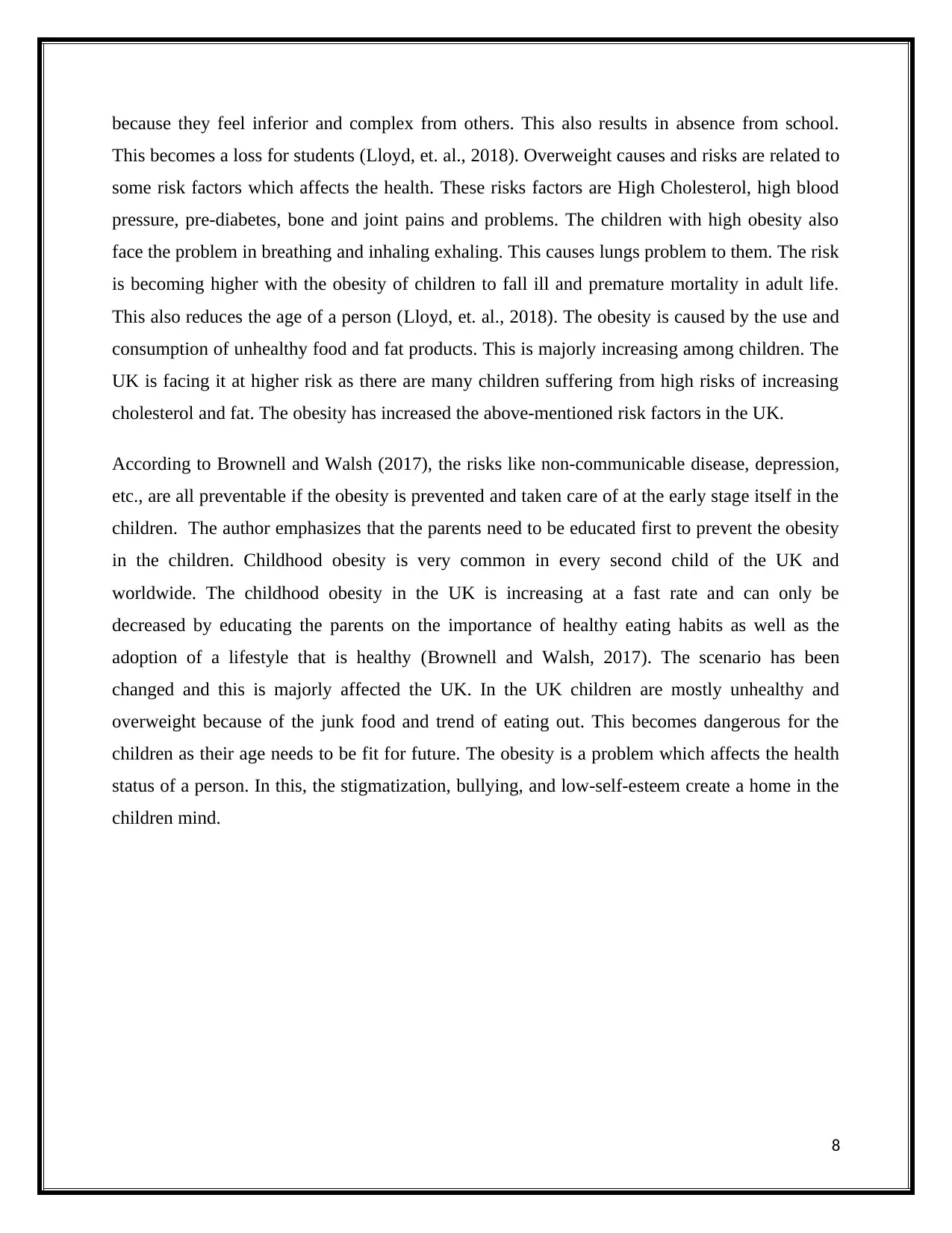
because they feel inferior and complex from others. This also results in absence from school.
This becomes a loss for students (Lloyd, et. al., 2018). Overweight causes and risks are related to
some risk factors which affects the health. These risks factors are High Cholesterol, high blood
pressure, pre-diabetes, bone and joint pains and problems. The children with high obesity also
face the problem in breathing and inhaling exhaling. This causes lungs problem to them. The risk
is becoming higher with the obesity of children to fall ill and premature mortality in adult life.
This also reduces the age of a person (Lloyd, et. al., 2018). The obesity is caused by the use and
consumption of unhealthy food and fat products. This is majorly increasing among children. The
UK is facing it at higher risk as there are many children suffering from high risks of increasing
cholesterol and fat. The obesity has increased the above-mentioned risk factors in the UK.
According to Brownell and Walsh (2017), the risks like non-communicable disease, depression,
etc., are all preventable if the obesity is prevented and taken care of at the early stage itself in the
children. The author emphasizes that the parents need to be educated first to prevent the obesity
in the children. Childhood obesity is very common in every second child of the UK and
worldwide. The childhood obesity in the UK is increasing at a fast rate and can only be
decreased by educating the parents on the importance of healthy eating habits as well as the
adoption of a lifestyle that is healthy (Brownell and Walsh, 2017). The scenario has been
changed and this is majorly affected the UK. In the UK children are mostly unhealthy and
overweight because of the junk food and trend of eating out. This becomes dangerous for the
children as their age needs to be fit for future. The obesity is a problem which affects the health
status of a person. In this, the stigmatization, bullying, and low-self-esteem create a home in the
children mind.
8
This becomes a loss for students (Lloyd, et. al., 2018). Overweight causes and risks are related to
some risk factors which affects the health. These risks factors are High Cholesterol, high blood
pressure, pre-diabetes, bone and joint pains and problems. The children with high obesity also
face the problem in breathing and inhaling exhaling. This causes lungs problem to them. The risk
is becoming higher with the obesity of children to fall ill and premature mortality in adult life.
This also reduces the age of a person (Lloyd, et. al., 2018). The obesity is caused by the use and
consumption of unhealthy food and fat products. This is majorly increasing among children. The
UK is facing it at higher risk as there are many children suffering from high risks of increasing
cholesterol and fat. The obesity has increased the above-mentioned risk factors in the UK.
According to Brownell and Walsh (2017), the risks like non-communicable disease, depression,
etc., are all preventable if the obesity is prevented and taken care of at the early stage itself in the
children. The author emphasizes that the parents need to be educated first to prevent the obesity
in the children. Childhood obesity is very common in every second child of the UK and
worldwide. The childhood obesity in the UK is increasing at a fast rate and can only be
decreased by educating the parents on the importance of healthy eating habits as well as the
adoption of a lifestyle that is healthy (Brownell and Walsh, 2017). The scenario has been
changed and this is majorly affected the UK. In the UK children are mostly unhealthy and
overweight because of the junk food and trend of eating out. This becomes dangerous for the
children as their age needs to be fit for future. The obesity is a problem which affects the health
status of a person. In this, the stigmatization, bullying, and low-self-esteem create a home in the
children mind.
8

Methodology
Childhood obesity in the UK is a problem which is a personal issue considering the methodology
in the manner to disseminate the issue to the world. The methodology used for this purpose is
considered to be the effective medium for providing the information. In the research report, the
methodology would be based on the primary and secondary methods of data collection. The data
collection I the research is the essence of the organization (Ospina-Pinillos, et. al., 2018). The
data collection is to be done on the basis of an effective medium of data analysis and data
collection. The methodology is based on the research facts and requirements. The primary data
collection includes sampling, questionnaire, and random sampling. The primary method is
considered to obtain the raw information from different sources and analyse and interpret the
information in the research report (Ospina-Pinillos, et. al., 2018). The secondary method of data
collection includes the literature review, conceptual framework, analysis of facts and figures,
analysis of graphical presentation etc.
The methodology of the research also includes the analysis methods which are qualitative and
quantitative methods. The qualitative methods include a quality analysis proper focus on the
quality information obtained (Carey, et. al., 2017). In the quality of information is analysed. The
quantitative research method includes quantified information or data such as quantitative
information. The graphs and past years data are analysed in this information. The sampling
methods would include 10 people from the hospital and child patients.
To ensure that the questionnaire is clear and ethical, the pre-test would be conducted which
would determine its actual implementation. The data collection and questionnaire analysed
would be tested before analysing so as to assure the validity of the report (Carey, et. al., 2017).
The research methodology would be effective and understandable.
9
Childhood obesity in the UK is a problem which is a personal issue considering the methodology
in the manner to disseminate the issue to the world. The methodology used for this purpose is
considered to be the effective medium for providing the information. In the research report, the
methodology would be based on the primary and secondary methods of data collection. The data
collection I the research is the essence of the organization (Ospina-Pinillos, et. al., 2018). The
data collection is to be done on the basis of an effective medium of data analysis and data
collection. The methodology is based on the research facts and requirements. The primary data
collection includes sampling, questionnaire, and random sampling. The primary method is
considered to obtain the raw information from different sources and analyse and interpret the
information in the research report (Ospina-Pinillos, et. al., 2018). The secondary method of data
collection includes the literature review, conceptual framework, analysis of facts and figures,
analysis of graphical presentation etc.
The methodology of the research also includes the analysis methods which are qualitative and
quantitative methods. The qualitative methods include a quality analysis proper focus on the
quality information obtained (Carey, et. al., 2017). In the quality of information is analysed. The
quantitative research method includes quantified information or data such as quantitative
information. The graphs and past years data are analysed in this information. The sampling
methods would include 10 people from the hospital and child patients.
To ensure that the questionnaire is clear and ethical, the pre-test would be conducted which
would determine its actual implementation. The data collection and questionnaire analysed
would be tested before analysing so as to assure the validity of the report (Carey, et. al., 2017).
The research methodology would be effective and understandable.
9
⊘ This is a preview!⊘
Do you want full access?
Subscribe today to unlock all pages.

Trusted by 1+ million students worldwide
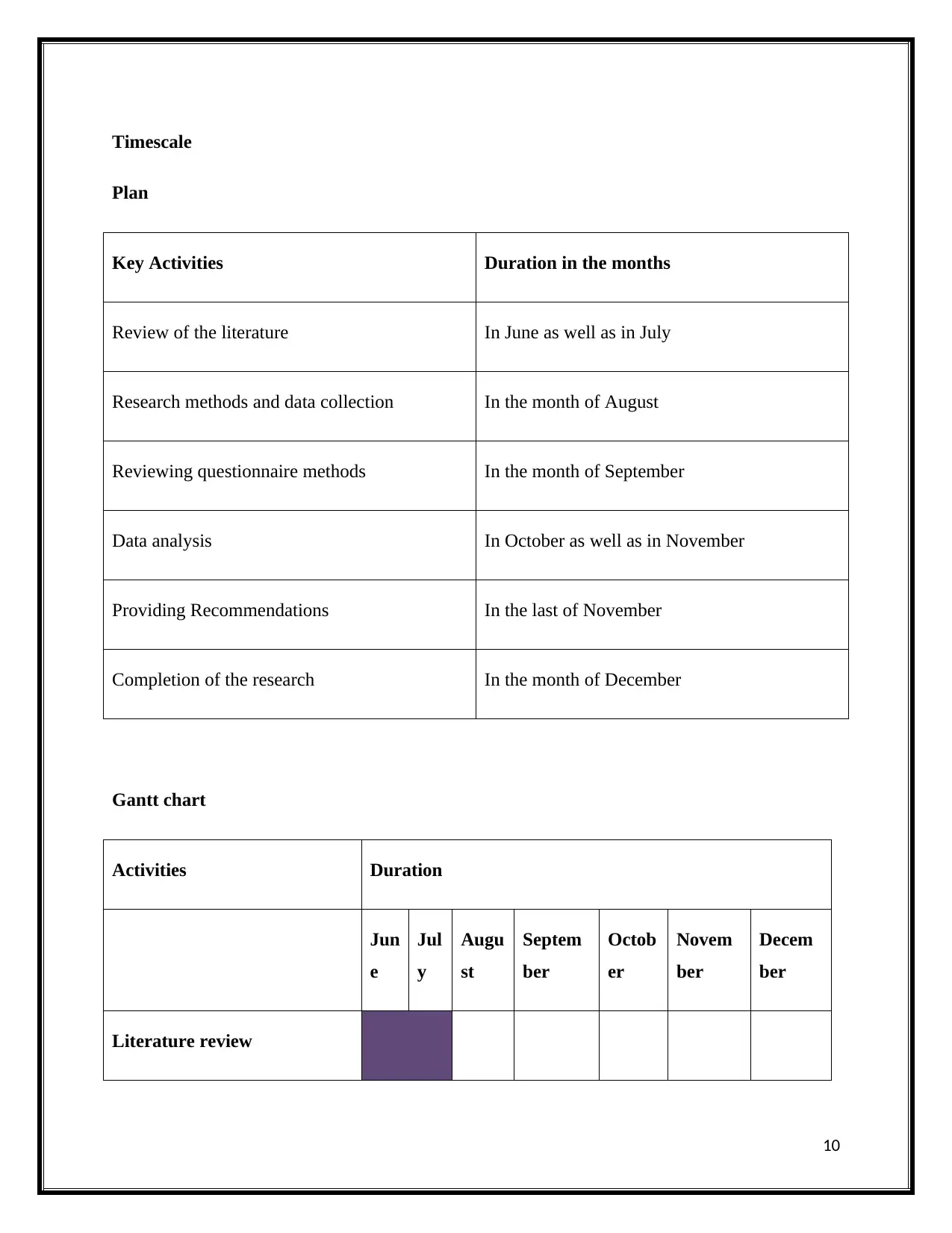
Timescale
Plan
Key Activities Duration in the months
Review of the literature In June as well as in July
Research methods and data collection In the month of August
Reviewing questionnaire methods In the month of September
Data analysis In October as well as in November
Providing Recommendations In the last of November
Completion of the research In the month of December
Gantt chart
Activities Duration
Jun
e
Jul
y
Augu
st
Septem
ber
Octob
er
Novem
ber
Decem
ber
Literature review
10
Plan
Key Activities Duration in the months
Review of the literature In June as well as in July
Research methods and data collection In the month of August
Reviewing questionnaire methods In the month of September
Data analysis In October as well as in November
Providing Recommendations In the last of November
Completion of the research In the month of December
Gantt chart
Activities Duration
Jun
e
Jul
y
Augu
st
Septem
ber
Octob
er
Novem
ber
Decem
ber
Literature review
10
Paraphrase This Document
Need a fresh take? Get an instant paraphrase of this document with our AI Paraphraser
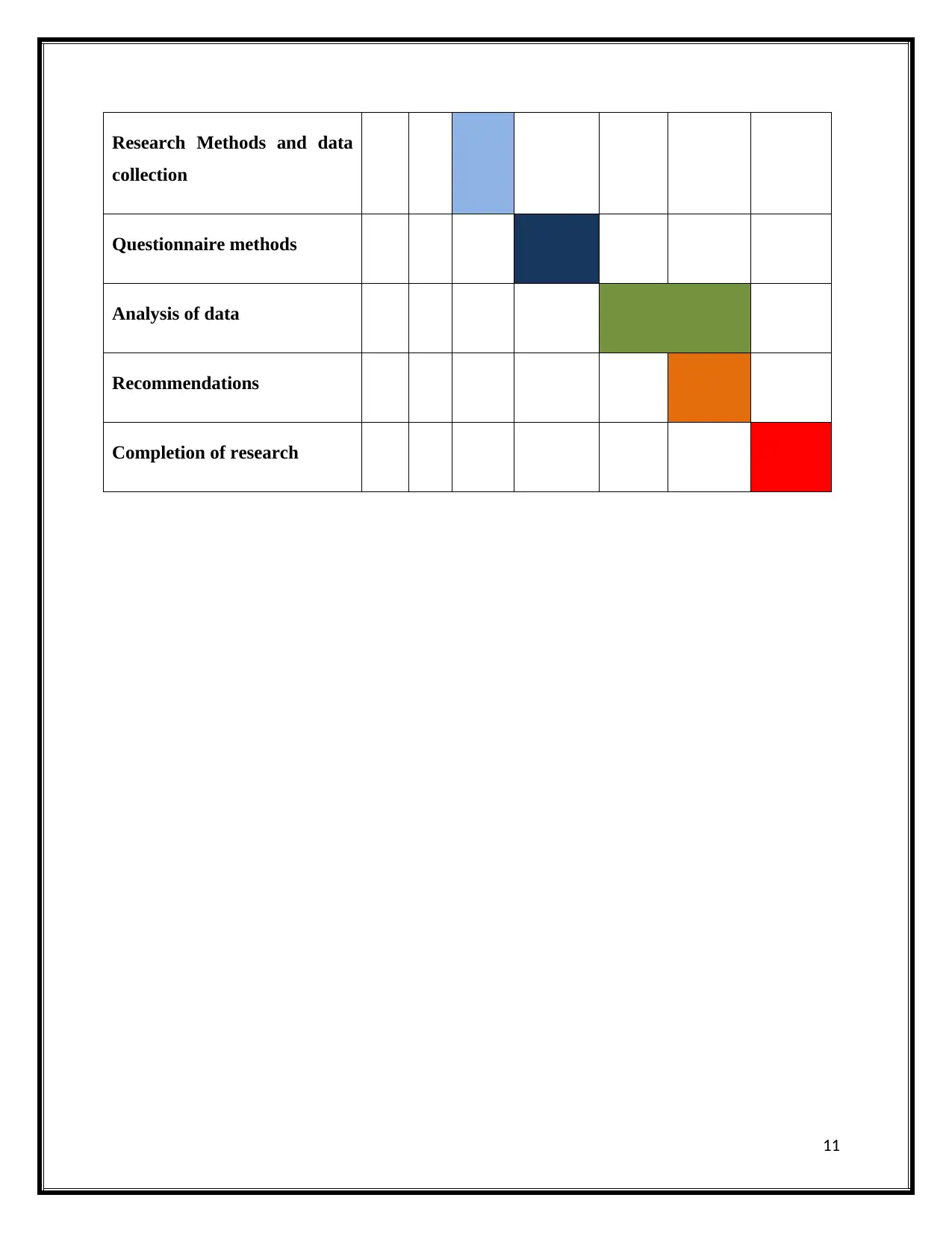
Research Methods and data
collection
Questionnaire methods
Analysis of data
Recommendations
Completion of research
11
collection
Questionnaire methods
Analysis of data
Recommendations
Completion of research
11

References
Brownell, K.D. and Walsh, B.T. eds., 2017. Eating disorders and obesity: A
comprehensive handbook. Guilford Publications.
Carey, T.A., Tai, S.J., Mansell, W., Huddy, V., Griffiths, R. and Marken, R.S., 2017.
Improving professional psychological practice through an increased repertoire of research
methodologies: Illustrated by the development of MOL. Professional Psychology:
Research and Practice, 48(3), p.175. Deneke, A.T., 2017. Childhood obesity and associated problems. Bachelors Thesis
Abstract, Turku University of Applied Sciences.
Lloyd, J., Creanor, S., Logan, S., Green, C., Dean, S.G., Hillsdon, M., Abraham, C.,
Tomlinson, R., Pearson, V., Taylor, R.S. and Ryan, E., 2018. Effectiveness of the
Healthy Lifestyles Programme (HeLP) to prevent obesity in UK primary-school children:
a cluster randomised controlled trial. The lancet child & adolescent health, 2(1), pp.35-
45.
Ospina-Pinillos, L., Davenport, T.A., Ricci, C.S., Milton, A.C., Scott, E.M. and Hickie,
I.B., 2018. Developing a Mental Health eClinic to Improve Access to and Quality of
Mental Health Care for Young People: Using Participatory Design as Research
Methodologies. Journal of medical Internet research, 20(5), p.e188.
Schmidt, M.D., Magnussen, C.G., Rees, E., Dwyer, T. and Venn, A.J., 2016. Childhood
fitness reduces the long-term cardiometabolic risks associated with childhood
obesity. International Journal of Obesity, 40(7), p.1134.
Skinner, A.C., Perrin, E.M., Moss, L.A. and Skelton, J.A., 2015. Cardiometabolic risks
and severity of obesity in children and young adults. New England Journal of
Medicine, 373(14), pp.1307-1317.
Wilkie, H.J., Standage, M., Gillison, F.B., Cumming, S.P. and Katzmarzyk, P.T., 2016.
Multiple lifestyle behaviours and overweight and obesity among children aged 9–11
years: results from the UK site of the International Study of Childhood Obesity, Lifestyle
and the Environment. BMJ open, 6(2), p.e010677
12
Brownell, K.D. and Walsh, B.T. eds., 2017. Eating disorders and obesity: A
comprehensive handbook. Guilford Publications.
Carey, T.A., Tai, S.J., Mansell, W., Huddy, V., Griffiths, R. and Marken, R.S., 2017.
Improving professional psychological practice through an increased repertoire of research
methodologies: Illustrated by the development of MOL. Professional Psychology:
Research and Practice, 48(3), p.175. Deneke, A.T., 2017. Childhood obesity and associated problems. Bachelors Thesis
Abstract, Turku University of Applied Sciences.
Lloyd, J., Creanor, S., Logan, S., Green, C., Dean, S.G., Hillsdon, M., Abraham, C.,
Tomlinson, R., Pearson, V., Taylor, R.S. and Ryan, E., 2018. Effectiveness of the
Healthy Lifestyles Programme (HeLP) to prevent obesity in UK primary-school children:
a cluster randomised controlled trial. The lancet child & adolescent health, 2(1), pp.35-
45.
Ospina-Pinillos, L., Davenport, T.A., Ricci, C.S., Milton, A.C., Scott, E.M. and Hickie,
I.B., 2018. Developing a Mental Health eClinic to Improve Access to and Quality of
Mental Health Care for Young People: Using Participatory Design as Research
Methodologies. Journal of medical Internet research, 20(5), p.e188.
Schmidt, M.D., Magnussen, C.G., Rees, E., Dwyer, T. and Venn, A.J., 2016. Childhood
fitness reduces the long-term cardiometabolic risks associated with childhood
obesity. International Journal of Obesity, 40(7), p.1134.
Skinner, A.C., Perrin, E.M., Moss, L.A. and Skelton, J.A., 2015. Cardiometabolic risks
and severity of obesity in children and young adults. New England Journal of
Medicine, 373(14), pp.1307-1317.
Wilkie, H.J., Standage, M., Gillison, F.B., Cumming, S.P. and Katzmarzyk, P.T., 2016.
Multiple lifestyle behaviours and overweight and obesity among children aged 9–11
years: results from the UK site of the International Study of Childhood Obesity, Lifestyle
and the Environment. BMJ open, 6(2), p.e010677
12
⊘ This is a preview!⊘
Do you want full access?
Subscribe today to unlock all pages.

Trusted by 1+ million students worldwide
1 out of 12
Related Documents
Your All-in-One AI-Powered Toolkit for Academic Success.
+13062052269
info@desklib.com
Available 24*7 on WhatsApp / Email
![[object Object]](/_next/static/media/star-bottom.7253800d.svg)
Unlock your academic potential
Copyright © 2020–2025 A2Z Services. All Rights Reserved. Developed and managed by ZUCOL.




